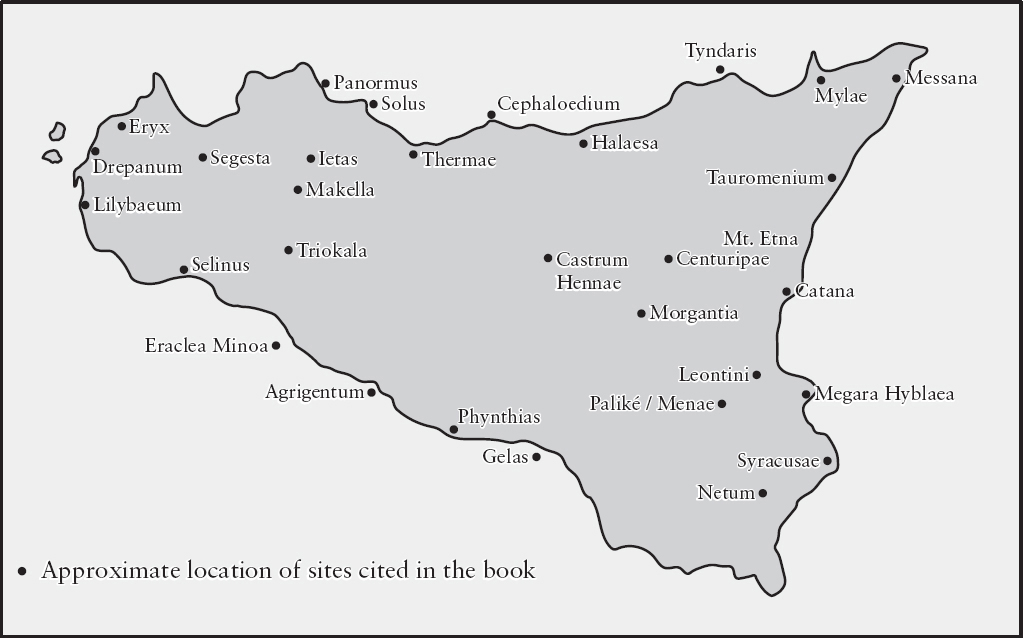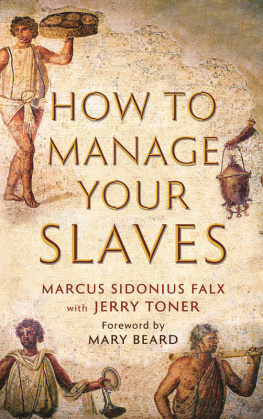Pagebreaks of the print version

Romes Sicilian Slave Wars
Romes Sicilian Slave Wars
The Revolts of Eunus & Salvius 136132 & 105100 BC
Natale Barca
First published in Great Britain in 2020 by
Pen & Sword Military
An imprint of
Pen & Sword Books Ltd
Yorkshire Philadelphia
Copyright Natale Barca 2020
ISBN 978 1 52676 746 2
eISBN 978 1 52676 747 9
Mobi ISBN 978 1 52676 748 6
The right of Natale Barca to be identified as Author of this work has been asserted by him in accordance with the Copyright, Designs and Patents Act 1988.
A CIP catalogue record for this book is
available from the British Library.
All rights reserved. No part of this book may be reproduced or transmitted in any form or by any means, electronic or mechanical including photocopying, recording or by any information storage and retrieval system, without permission from the Publisher in writing.
Pen & Sword Books Limited incorporates the imprints of Atlas, Archaeology, Aviation, Discovery, Family History, Fiction, History, Maritime, Military, Military Classics, Politics, Select, Transport, True Crime, Air World, Frontline Publishing, Leo Cooper, Remember When, Seaforth Publishing, The Praetorian Press, Wharncliffe Local History, Wharncliffe Transport, Wharncliffe True Crime and White Owl.
For a complete list of Pen & Sword titles please contact
PEN & SWORD BOOKS LIMITED
47 Church Street, Barnsley, South Yorkshire, S70 2AS, England
E-mail:
Website: www.pen-and-sword.co.uk
Or
PEN AND SWORD BOOKS
1950 Lawrence Rd, Havertown, PA 19083, USA
E-mail:
Website: www.penandswordbooks.com
Preface
I n 136 BC the slaves at work in the Sicilian countryside revolted against their owners, quickly taking control of large parts of the island and keeping them until the intervention of the Roman legions in 131 BC. A second movement followed the first in 105 BC, with similar results. The ancient sources agree in identifying the causes of these uprisings, both in the mistreatment suffered by slaves from their masters, especially those who were required to work the land, and in the tendency of the Roman authorities to tolerate the behaviour of certain wealthy owners of estates, often senators, who armed their slave-shepherds and pushed them to commit criminal acts. The most important of such sources is Diodorus of Sicily, a Greek-speaking Sicilian aristocrat who lived in 1st century BC at Adrano, near Catania. This historian, in his main work, called the two movements of slaves cited above the Revolt of Eunus and the Revolt of Salvius, and this definition survives to this day.
While the revolts ended in 102, they left their mark on the history of Sicily as well as on that of the Roman Republic. They introduced a crisis that was both social and civil. The crisis lasted for decades, and led to the Social War (9188 BC) and the rebellion of Spartacus.
The latter broke out in 73 BC in Capua (now Santa Maria Capua Vetere), a large city located near Naples, in Campania, and raged for three years in various parts of central and southern Italy. It developed to such a large scale, and became so famous, as to obscure the memory of all other similar events.
Romes Sicilian Slave Wars are often linked to the rebellion of Spartacus. Today they are little known by the general public, while the revolt of Spartacus is far better known. It is likely that the former did not have the same echo of the latter because Spartacus and his companions were gladiators and Spartacus himself was a charismatic leader, more so than Eunus, Salvius or Athenion.
In this book I tell the story of Romes Sicilian Slave Wars.
I provide a detailed reconstruction of the facts as far as it is possible to deduce from the ancient sources framing them in the broader context of Hellenistic Sicily and the history of Rome.
I include evidence that the insurgents founded a kingdom and fought for freedom and political self-determination, and explain why this aspect little emphasized by the ancient sources, and only to ridicule the king of the slaves is central to understand what really happened.
I also explain why the Rebellion of Spartacus was something quite different, and thus why it is inappropriate to link it to the revolts of Eunus and Salvius.
A monument to Eunus exists in Enna, Sicily, outside the ancient citadel. It is a bronze statue, about three metres high, depicting a man who screams while breaking his chains. It was erected by the local municipality in 1960 to celebrate the triumph of freedom against slavery. This initiative took a cue from the revolt of Eunus, which started in Enna and from there spread to large parts of Sicily. After being the cradle of the revolt (in spite of itself), Enna also became the theatre of its tragic epilogue.
Some final notes. The language used in this book has been made as simple as possible to make it accessible even to a non-specialized public. All dates shown are BC unless otherwise specified. So, from here on, BC will no longer be indicated for the sake of brevity, while AD will be always indicated unless it is clearly unnecessary. As for place names, the name indicated first is the original. The names in brackets are those attributed subsequently to the place considered, and the last is the modern equivalent.
Natale Barca
Trieste, Italy, March 2020
Acknowledgments
R omes Sicilian Slave Wars is the result of a research project carried on by the author at the Hellenic and Roman Library (HARL) at Senate House, in Londons Bloomsbury. HARL is one of the worlds great libraries for the study of Greco-Roman Antiquity, a resource without parallel for international researchers. I must warmly thank Professor Greg Woolf, Director of the Institute of Classical Studies, School of Advanced Studies (ICS), University of London, for having let me frequent such a library as an academic visitor of the ICS. I am also grateful to Carlos F. Norea, Professor of Ancient History at the University of California, Berkeley, CA, USA, and to Dr Marco Perale, University Teacher in Greek and Latin at the University of Liverpool, for having made this possible. A grateful thought also to Paul Richgruber, Professor of History at Lake Superior College, Duluth, MN, USA, for his encouragement. Many thanks also to Pen & Sword Books Ltd particularly to Philip Sidnell, Commissioning Editor, Matthew Jones, Production Manager, and Tony Walton, who did the copy edit for having published this book.

Map 1 : Sicily at the time of the First and the Second Slave War.

Map 2 : Spread of the Revolt of Salvius (First Slave War)

Map 3 : Rebel movements in the Revolt of Salvius (Second Slave War)

Map 4 : Spread of the Revolt of Salvius (Second Slave War)



















